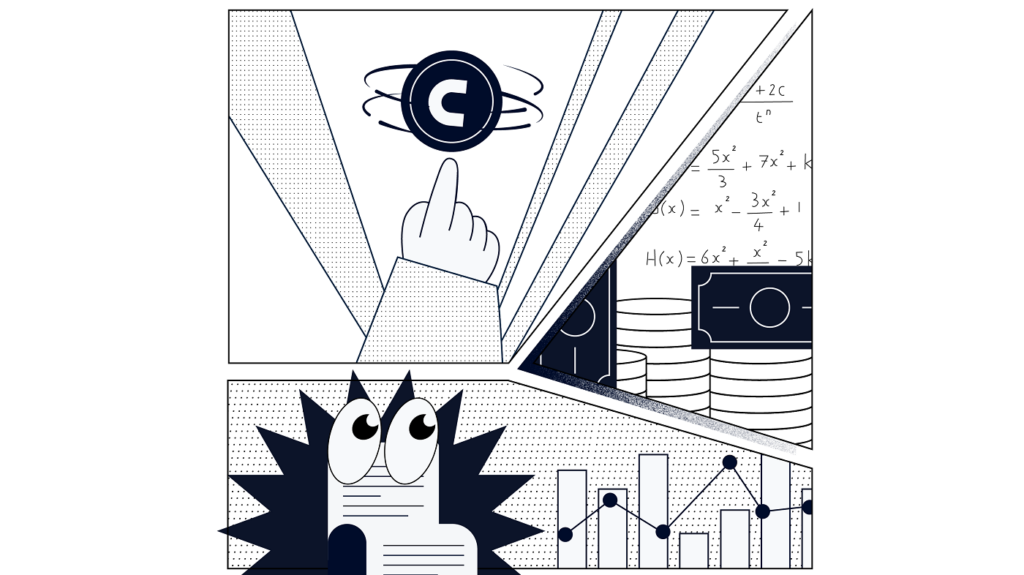When making a big purchase decision, what is the first thing that you do? Probably a little research to understand what market rates are like and what you should expect to spend. This is a slight oversimplification of a project estimate—but it’s what you’re doing.
Before kicking off a new project, your teams and clients are likely doing the same thing—trying to understand how much it will cost to complete the work.
But the cost isn’t the only thing that needs to be considered in your project estimation process; everyone will also need to understand how many people and how much time it will take to complete the work.
In the digital world, prices, staffing, and timelines can vary widely for similar projects. This is because there are so many variables, including:
- The scope of the work that needs to be completed
- The team members available to do the work
- The skill sets of the team members on the project
- How much time the team has to complete the work
So how does a project manager and their project team determine how much something will cost before they’ve started doing the work?
Cost estimation can be a real challenge—creating a project budget that works for your team and clients if you work for an agency is a blend of art and (data) science.
This guide will provide you with the tools and techniques you’ll need in order to create more accurate estimates.
What Is A Project Estimate, And When Do You Need One?
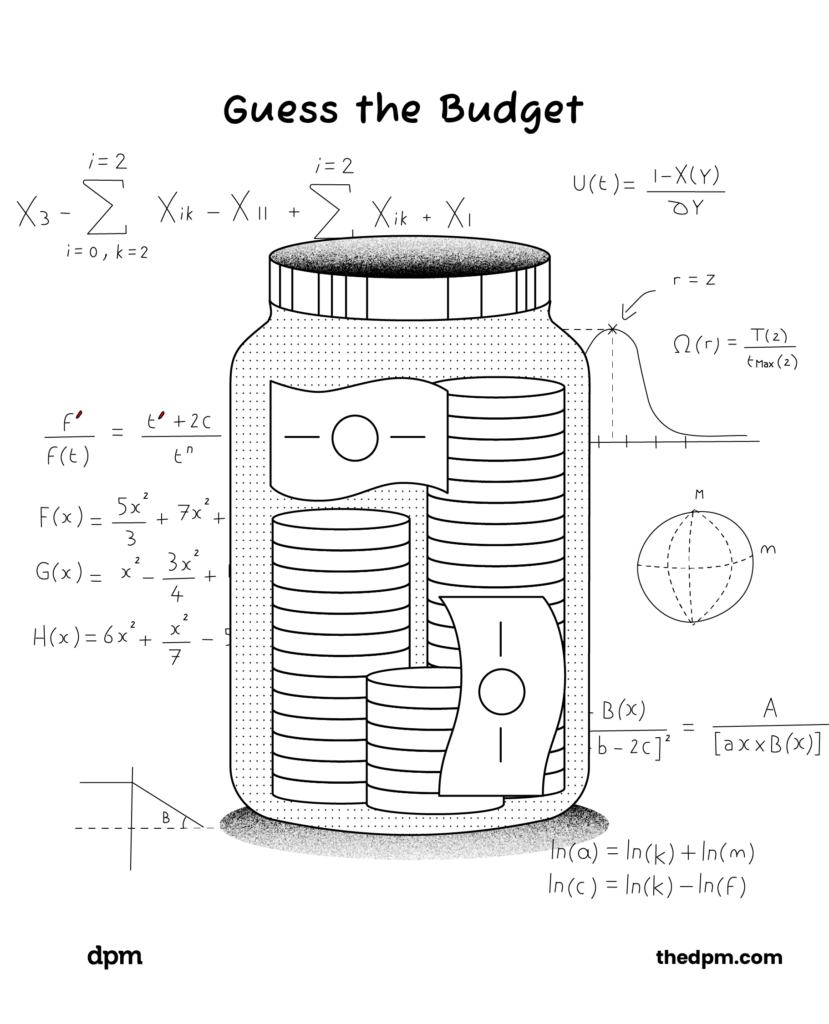
An estimate is simply an approximate calculation of the effort and cost it might take to complete a project.
It’s not a guarantee of the final cost—instead, it provides a client with a quote or guide (often a ballpark range estimate) of how much it might cost to do or deliver something so that they can secure the budget to start the project. Budgetary estimates are made before a project is officially started.
New to estimation or want to practice? You can download the project budget template for a website redesign below. By the end of this post, you’ll know which type of estimate to use—and when—and the steps and tools to manage your project estimate and, ultimately, your project budget.
What's the difference between an estimate and a budget?
An estimate is an approximation, while a budget is the total amount of funds you have to complete your project. Usually, a project estimate becomes a project budget after the project sponsor or client approves it.
One important distinction before we really dive in: before you estimate, you should know how much things cost internally. This number may be less than you actually bill a client (to account for overhead and profit).
You should know the hard costs of doing business before you provide a client-facing estimate (Note that this doesn’t apply to in-house digital teams).
This article won’t focus on how to determine costs, as we can cover that in another article.
Why Do Project Estimates Matter?
Estimating might seem like a painful process, but it’s a crucial one. And while it might be tempting to copy and paste a cost estimate and send it on its merry way, it’s important for project managers to understand that every cost estimate is unique.
Estimating is a fundamental part of the role of project management—the process of calculating how much a project might cost is important in defining the parameters of a project.
Here’s why you need to create an estimate for your project before getting kicking off the work:
- Estimates provide pricing guidelines: you need to know what you’re going to charge the clients (and when) so the client can decide whether they have the budget and whether it’s worth the investment to proceed with the project
- Estimates provide clarity: when you know how much budget a client has, the process of producing a cost estimate helps define the approach. You can use what you know of the overall budget to determine project roles, responsibilities, and deliverables. If a client’s budget is 20% under your estimate, for example, you can consider reducing the number of deliverables in the project or try reallocating resources in order to avoid overspending.
- Estimates can help dictate a resource plan: when you complete an estimate, you may also outline the steps or approach you’ll take to complete the work, which can be used when creating your resourcing plan or building your project team.
What's Included In A Project Estimate?
The project estimate needs to include all costs associated with the project.
This could be the cost for the project team’s time (billed hourly or at a fixed project rate), the cost of any hardware or software licensing needed for the project work, licenses or subscriptions to any third-party software that will need to be integrated as part of the project and any other costs that will be charged back to the client for any reason.
Some project estimates also include a contingency budget. This can be really helpful if there are any unknowns about the project. Having 10-20% of the budget as a contingency can give project managers and their teams a little “wiggle room” when creating an estimate.
If you and your team do add a contingency to your estimate, be sure to align with your client on how you’ll communicate your needs to dip into this budget.
How project estimates are shared with clients or sponsors can vary from agency to agency or team to team. Some are more transparent than others. A word of advice, the more transparent you can be, the easier it is to make sure nothing is overlooked and that everyone is aligned on the costs.
3 Types Of Project Estimates
What are the types of estimates? There are many, but here are a few of the most common estimates that digital agencies use:
Rough Order of Magnitude Estimates (ROM)
Sometimes called a ballpark estimate, a rough order of magnitude estimate helps a client understand the cost and level of effort involved in a project. This type of estimate is usually used very early in the process of deciding whether or not to move forward with a new project and is generally a rough estimate provided as a range.
For example, if a client is looking to your agency to build a new website and you know your agency’s sweet spot is website projects in the $95,000 to $150,000 range, but their budget is only $50,000 the client might determine the project is not a fit for your agency and may look for an agency that more closely aligns with their budget and needs.
Budget Estimate
A budget estimate is going to be much more specific. You should use a budget estimate when the client is fairly confident that they have the budget, but they need a little bit more detail around how it would be allocated before they decide to move forward with the project.
Let’s say your client is happy with the rough order of magnitude estimate you provided. The next step will be to put together the proposed project plan along with the cost for each phase or deliverable. You could even include a suggested timeline that tells your client when you could kick off and how long the project will take.
If your rough estimate was a wider range, you could even consider creating two budget estimates, one for the high end and one for the low end. While it’s likely you and your client will shoot for the middle of the range, this will give some more specific information about what they would get (and when) at each end of the range.
Definitive SoW Estimate
Use a definitive SoW estimate when you’ve completed all due diligence and need project budget approval.
Let’s say this client was really happy with your budget estimate, and they are ready to move forward with the work. The final step in estimate refinement is pulling together the statement of work (SoW), which will include the estimate and total project budget.
Remember that the SoW is what you’re building your contract with the client on—it should outline the full project scope and the costs associated with it. So if there are any changes to the project budget (or the project scope) after the SoW is signed, you will most likely need to execute a change order.
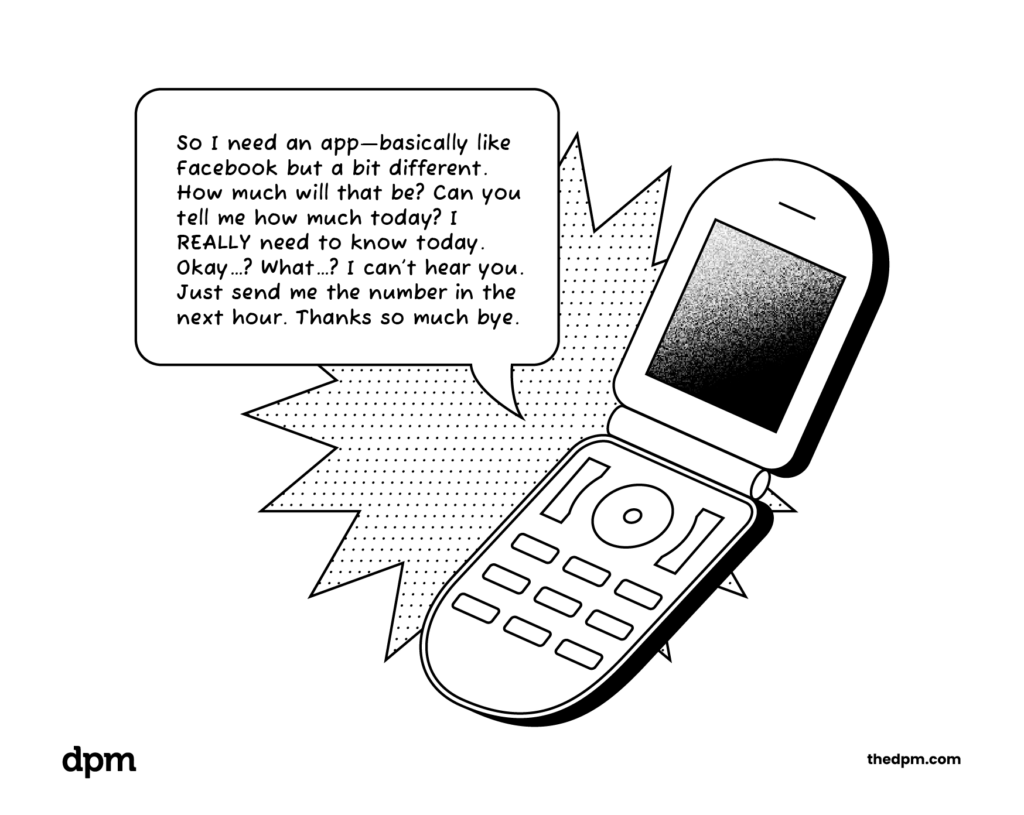
How To Calculate Project Estimates: 6 Estimation Techniques
So what are the project estimation methods in project management? There are a few different ways to estimate a project, and it’s worth being familiar with them so that you know what project estimation technique to use in your project and when to use it. In this section, we’re going to cover six estimation techniques:
1. Top-down Estimation
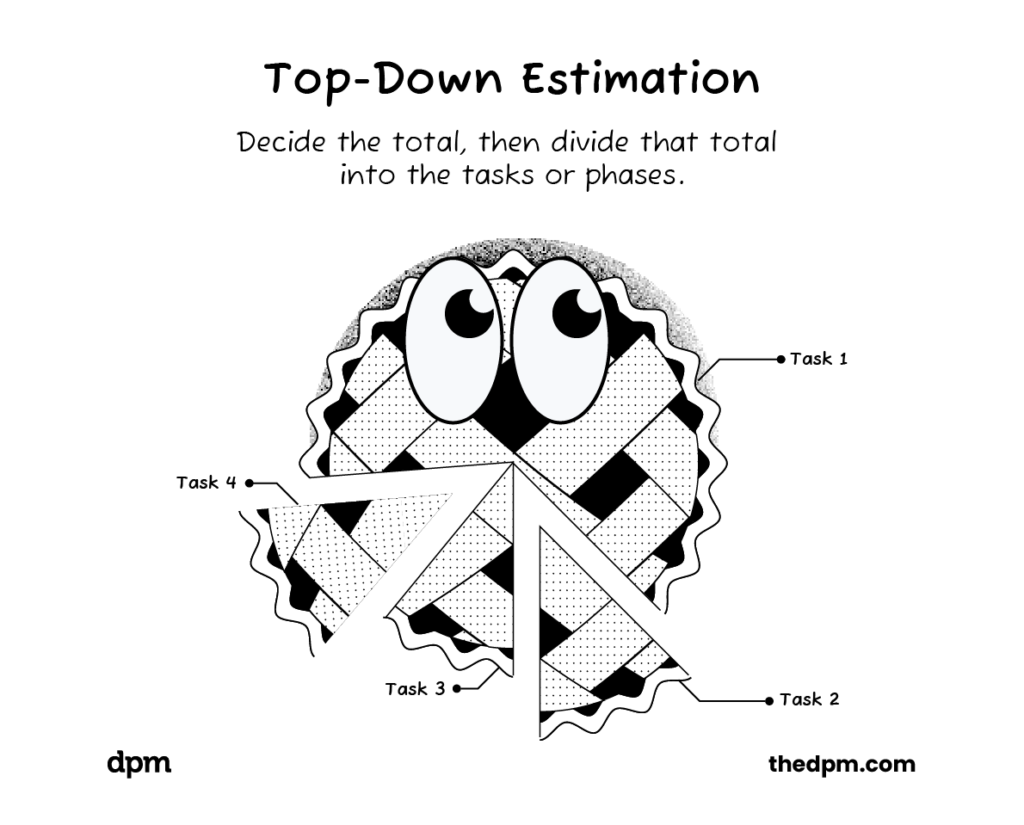
In a top-down estimate, you’ll decide (or have the client tell you) the final budget for the full scope of work and then divide that total into the tasks or phases.
Once you have the budget broken out by task or phase, you can look at these smaller chunks of work to determine if the allocated budget feels like enough.
This is where the art and science part comes in. You might have some data about how long certain tasks may take to help you decide if these estimates feel right. You also want to use your experience and intuition to understand where things in the project may need more time or resources than they typically do.
This could be because of the creative needs or because you’re working on an app that has more complex functionality than the team has ever worked on.
Top-down estimating is a useful technique to use in the early phases of a project when you’re trying to validate if a client’s budget is sufficient to deliver a project.
The advantage of top-down estimating is that it can be a very quick way to produce an estimate. This can be useful if you’re trying to help a client determine whether or not their budget is viable. It’s also useful in helping a client try and understand what kind of scope their budget might allow for.
The disadvantage of top-down estimating is that it’s not always accurate. If you use a top down estimate as a starting point, you will want to make sure to validate with your team that the budget is allocated correctly in order for them to complete all of the needed project work before moving this estimate into a statement of work.
2. Analogous Estimation
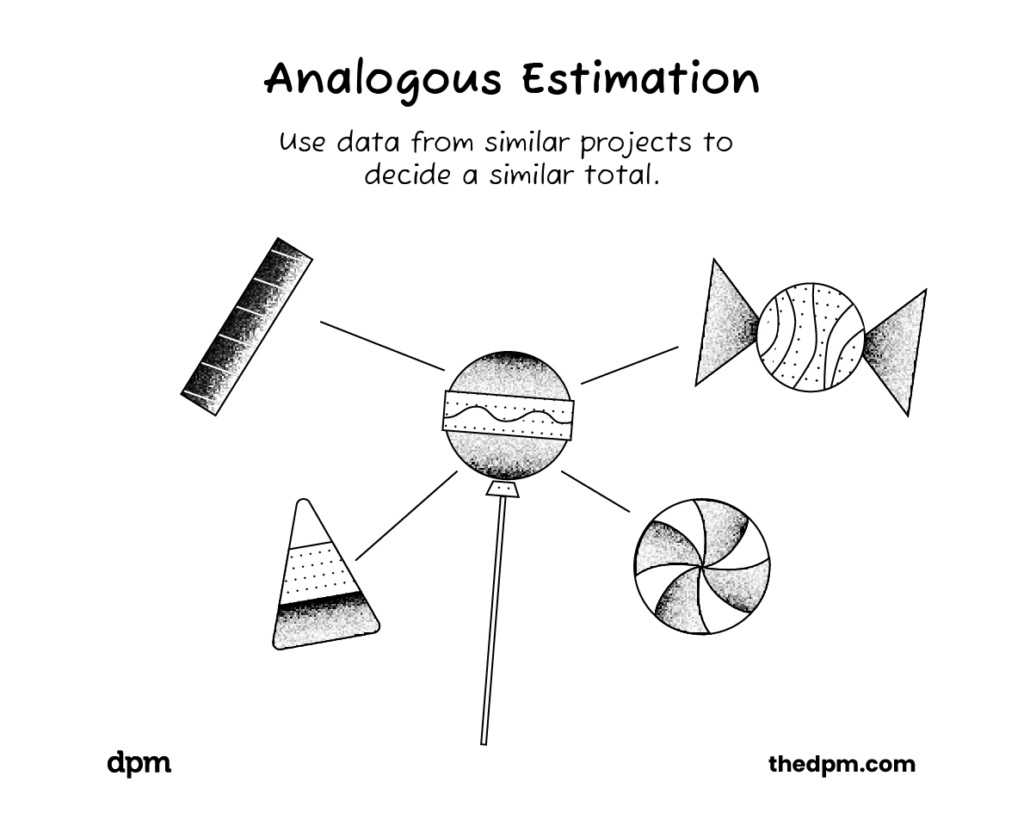
The analogous estimation process uses data from similar projects to determine the overall project cost.
An example of analogous estimating would be if a client came to you asking for a website re-design and wanted to know how much that might cost. You would then go look at similar projects and base your initial estimate on what past projects billed.
Remember that if you are looking at projects over a year or so old, you’ll want to adjust your estimate for any rate or cost increases to keep the budget estimate as accurate as possible.
Simple right? Well, yes, if you’ve actually got relevant historical data that accurately matches the current project you’re trying to estimate. It assumes you’ve got data from previous projects that are similar enough to provide a useful comparison.
Analogous estimates can also be derived from examples outside your—or your team’s—project experience (for example, here’s a survey with rough figures on mobile app development costs).
Use caution—outside examples can be a good place to start if you’ve never done that type of project before, but you’ll still need to do a fair amount of due diligence as you break down the costs for your specific case.
The advantage of analogous estimating is that it’s very quick and easy and can be used with limited information available about the project—similarly to top-down estimating, it’s a great estimation technique to use when you just need a ballpark estimate.
The disadvantage of analogous estimating is that it can often be inaccurate. While there may be similarities between projects, projects are always unique – it’s often like trying to compare apples and oranges.
Furthermore, for analogous estimates to be viable and useful, they’re heavily reliant on accurate historical data (here’s a shameless plug for you to do some data analysis at the closing of your project!).
3. Parametric Estimation
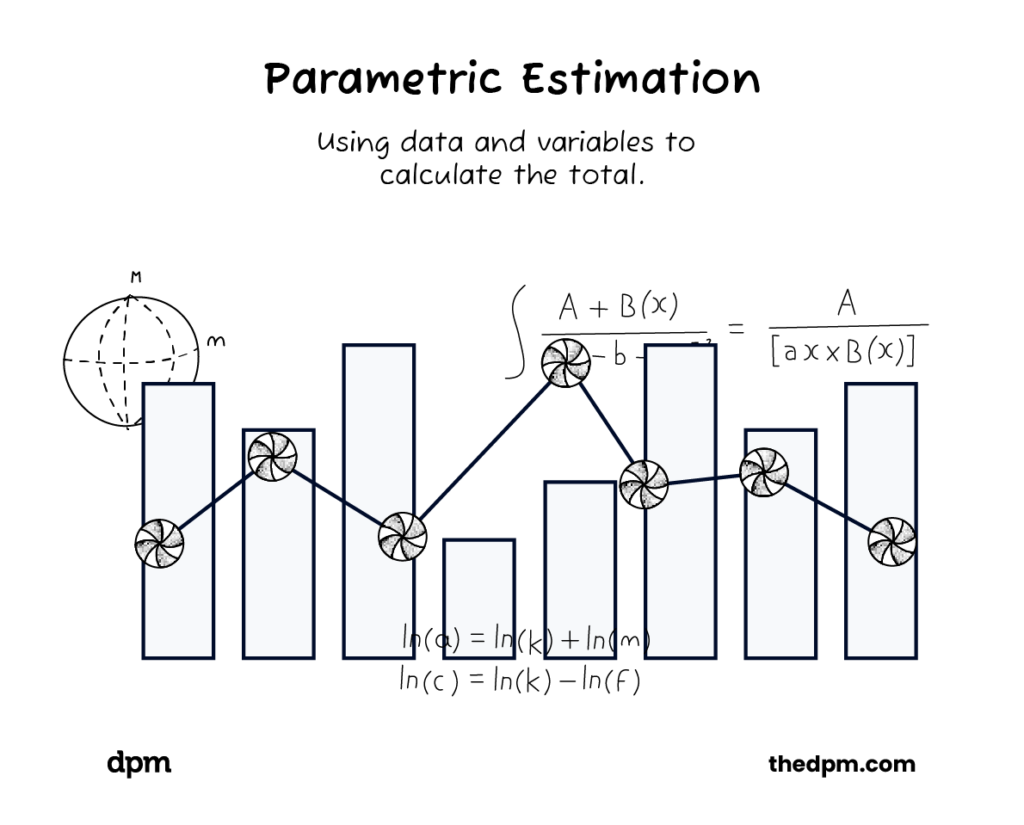
If you’ve got the data and some more time on your hands, a potentially more accurate ballpark estimating technique is parametric estimating. Parametric estimating takes variables from similar projects and applies them to the current project.
For example, suppose you had a project to develop a 2-minute animation. Say the cost of a previous project that involved developing a 30 second animation was $10,000. You could then extrapolate the cost for the current project would be roughly 4 times the cost, or around $40,000.
The advantage of this process is that it’s more accurate than analogous estimation because it employs more than one data set and uses the statistical relationship between historical data and variables.
The disadvantage is that with digital projects, it’s often hard to find useful data points as there is a lot of variety between projects. One place this may not be true, is if you do repeat business with the same client.
Say your animation client loves their 30 second animation and comes back to you 6 weeks later to produce 2- 40 second animations. The data you have from the first project (assuming the next one is similar) can easily inform this new project.
4. Three Point Estimation
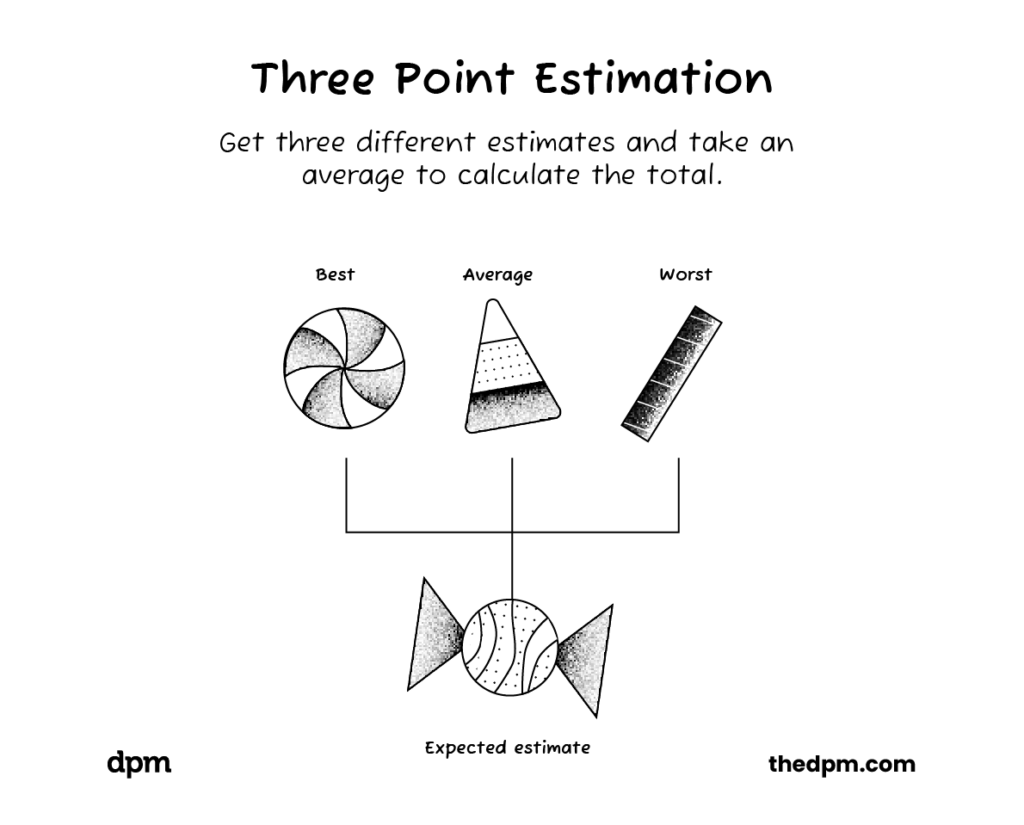
Assuming you’re done with ballpark estimating and the client has asked for a proper budget estimate, you need to start using more accurate estimating techniques. A single hourly estimate per task is easiest, but sometimes it’s nice to think in ranges and take a weighted average.
Three-point estimation is a way to calculate a realistic cost estimation using three data points:
- The best-case estimate
- The worst-case estimate
- The most likely estimate
How does this work? Let’s say, after discussing with your team, you estimate the time to design a web page as follows:
- Best case: 3 hours
- Worst case: 9 hours
- Most likely case: 5 hours
If you know the best and worst case, you can also average them to determine what is most likely (somewhere in between the best case and worst case).
The advantage of three-point estimating is that it reduces risk by taking into account best, worst-case, and most likely outcomes.
The only real disadvantages of three-point estimating are that it takes a bit longer to do, and if you’re estimating for tasks you’ve never done before, you might not know how long it will take.
5. Bottom-up Estimation
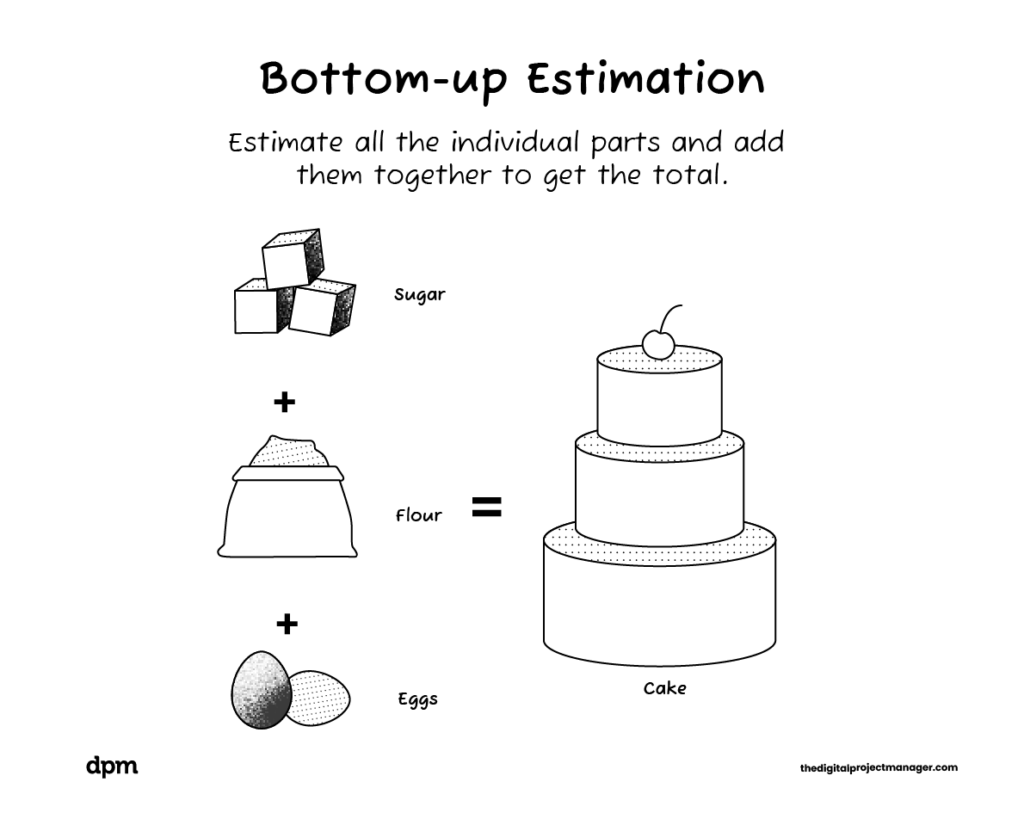
When you’re at the point of creating a statement of work, it can be helpful to do a bottom-up estimate.
Bottom-up estimating uses a work breakdown structure (WBS) which you can take from your project plan and break down a project into its individual tasks, which are estimated separately and then added together to calculate the total project cost.
The advantage of the bottom-up estimating technique is that it’s the most accurate and, by being granular, enables robust tracking of a project’s progress against the estimate. You know very quickly if a project is going over budget if tasks start taking longer than were estimated.
The disadvantage of bottom-up estimating is that it’s time-consuming to produce and can only really be used when you know all the details about every task in a project.
Also, by becoming very granular (and estimating at a task level), it can sometimes inflate the cost of an estimate. For this reason, it’s a great technique to use alongside analogous estimation when you’re trying to validate the appropriateness of your estimate.
6. Critical Path Method
The critical path method (CPM) has more to do with the project timeline than the budget. That said, while some of the estimation methods we’ve looked at in this article focus on estimating costs, we’ve also talked about the importance of your project’s estimate addressing the timeline for the work.
The critical path is the shortest duration between the project’s start and end. In a project, there are some tasks that can be performed concurrently and others that have dependencies.
For example, if your project was to implement software for a new digital kiosk, you cannot implement your developed software in the kiosk until the kiosk has been set up.
So the tasks for ordering and assembling the kiosk are on the critical path of the project, and the project cannot be completed (ie. the software can’t be installed) until the kiosk has been assembled and is ready for the software to be loaded into it.
How might the duration align with the budget? If your client wants the project delivered faster than is feasible with the current team and plan timeline, you may need to adjust the budget to accommodate your resource management and allow you to add people to the project to hit their target deadline. Resource management software might be useful for this type of analysis as it lets you visually organize efforts across the team and plan for any contingencies related to your resources.
Which Estimation Techniques Should You Use?
There’s no right or wrong estimating method, and sometimes you might use more than one per project! To determine which estimation technique to use, consider the type of estimate you need based on what you know about the work and where your team or client is in the decision-making process.
So while bottom-up estimating might seem like the best approach, it’s not always advisable when you are short on time and resources or you still have a lot of unknowns, even though it might be the most accurate.
Project Estimation In Practice
If you’ve never done a project estimate before, now is a good (safe) chance to give it a try.
For the purpose of this exercise, let’s make a cake. A very expensive cake.
Below, you’ll find a budgetary estimate for making a cake. You could present a document like this to a client and see if they could secure $1,000 to start the cake-making project. Then, after refining the cost estimate, you’d create a statement of work and get approval with a purchase order.
Then, you’d bake your kick-ass cake. Admittedly, it’s a ridiculously expensive cake, but hey, you deserve it.
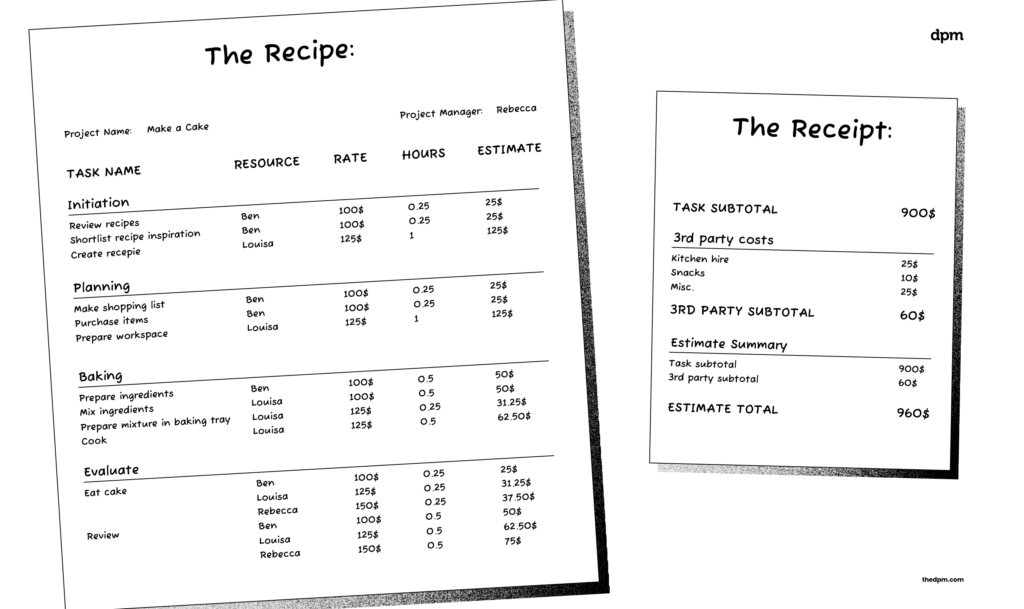
This example estimate includes some critical project information with the project name, project manager, and date. The estimate breaks down the tasks into phases and shows who will be doing what task in each phase of the project and what level of effort they will apply.

Importantly, this estimate example also shows third-party costs (which, very generously, we didn’t mark up) and an estimate summary that a client could use as their budget.
In this project budget example, we didn’t include a risk budget, change budget, contingency, or assumptions because, after all, it’s just a cake, and we’re trying to keep it simple.
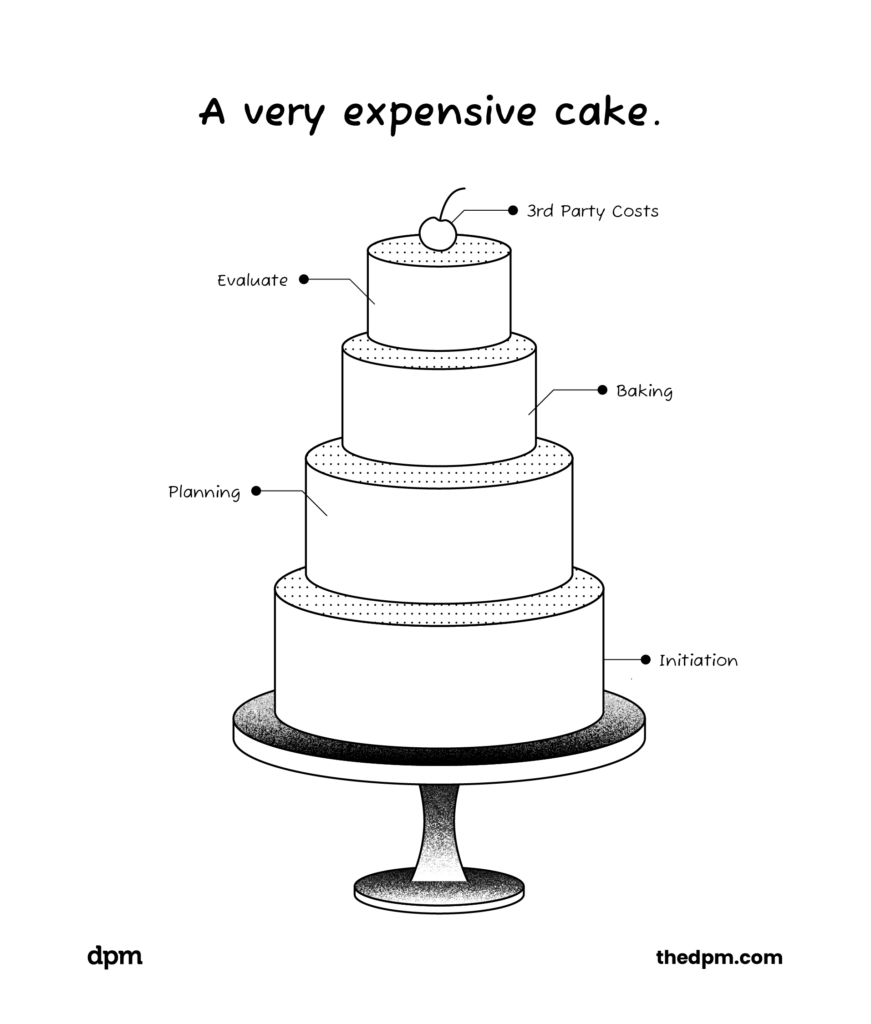
Project Estimate Template
If you’re on the hunt for a project estimate template, then you’re in luck. We’ve created this project budget template for a web design project that’s priced at $100k. It matches the project plan that we created, so that you can use the two in tandem.
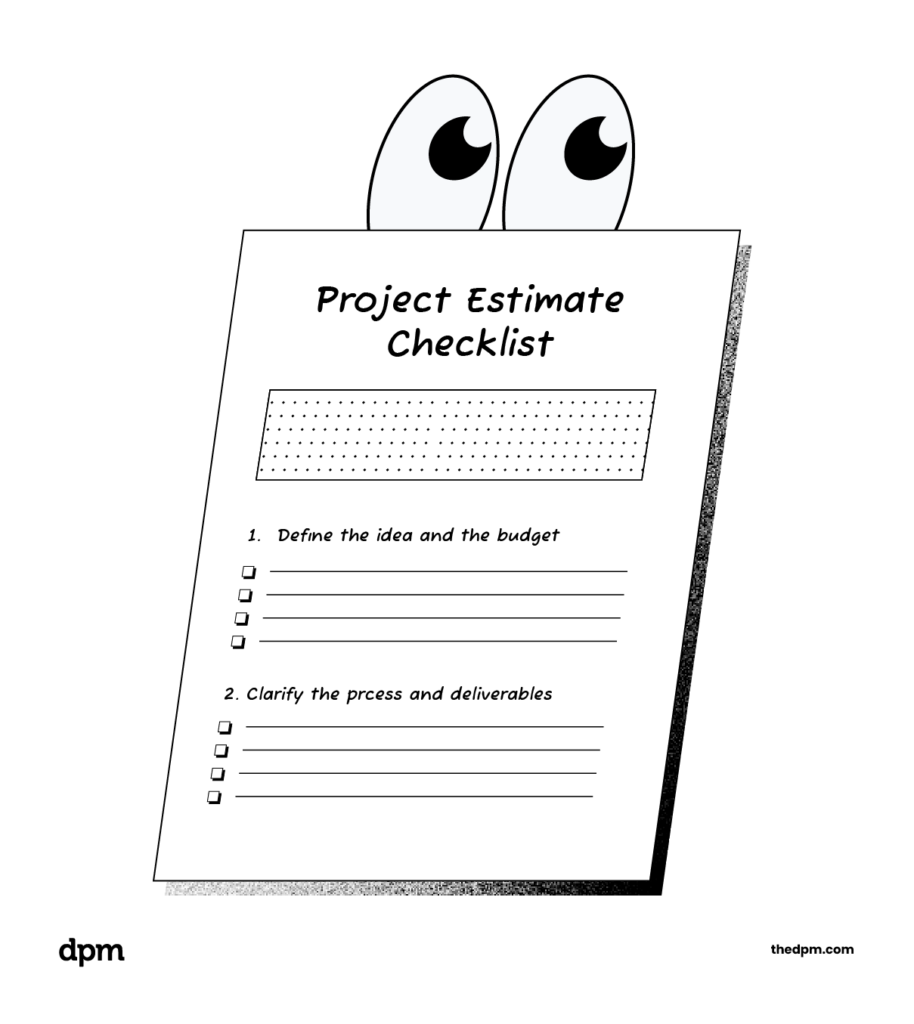
Download the template and use it as you follow along with the rest of this guide.
The files include project cost estimation and project estimate templates which you can repurpose for your own projects. If you’re looking for a project budget template for Excel, we’ve included that in this bundle, as well as a simple project estimate checklist.
5 Things To Know Before Creating A Project Estimate
In order to create your own estimate, there are some things you’ll need to know. Whether you’re working in-house and considering a new project for your team or functional area, or you work for an agency and are potentially being retained for client work, here’s what you want to gather in order to create the best estimate possible.
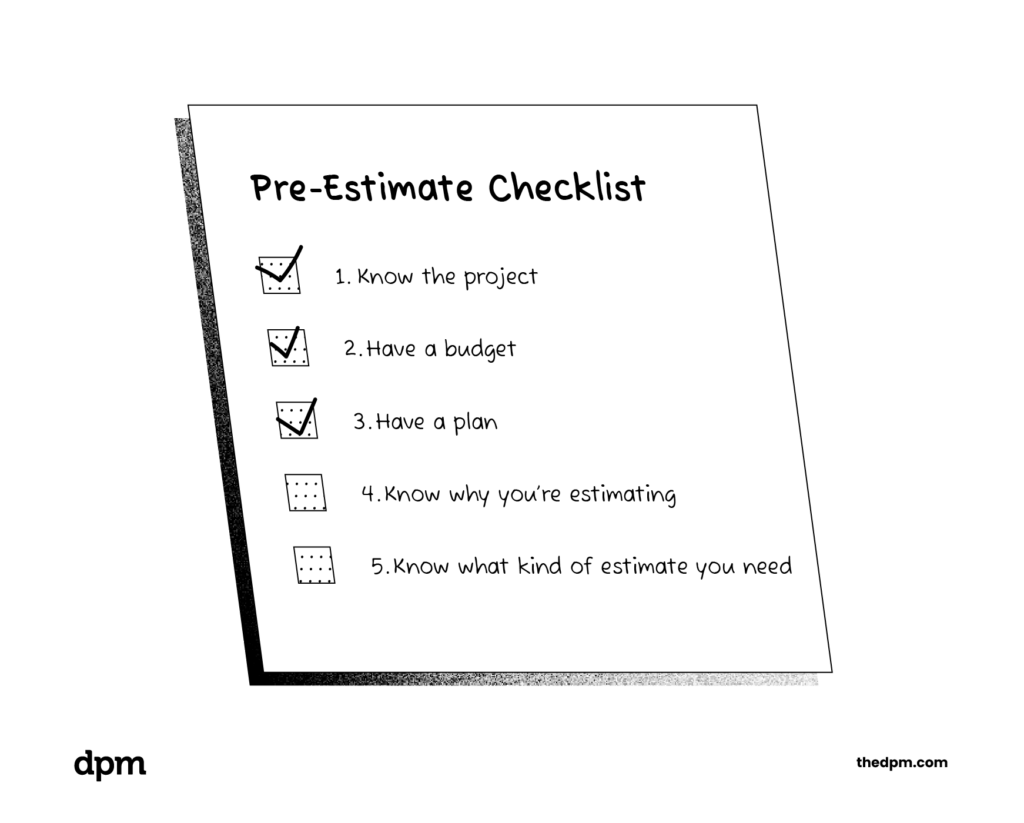
1. Define the project
Before you start estimating anything, the first thing you need to get your head around is why you’re doing the project in the first place. You have to understand the client’s brief, what they’re trying to achieve, and why.
You need to understand the desired results of the project and what success looks like to them. Without that basic understanding of strategic objectives, it’s difficult to know where to put an emphasis on effort in the project.
If the project is technical in nature, ask for any tech specs you can get. For example, for a website project, ask about what platform they want to build on, where it will be hosted, and any functionality or integrations that will need to be developed.
If your client doesn’t know yet, you have two choices: you can make (and document) some assumptions/recommendations based on their current site, or you can provide an estimated range and come back to it!
2. Ask about the Project Budget
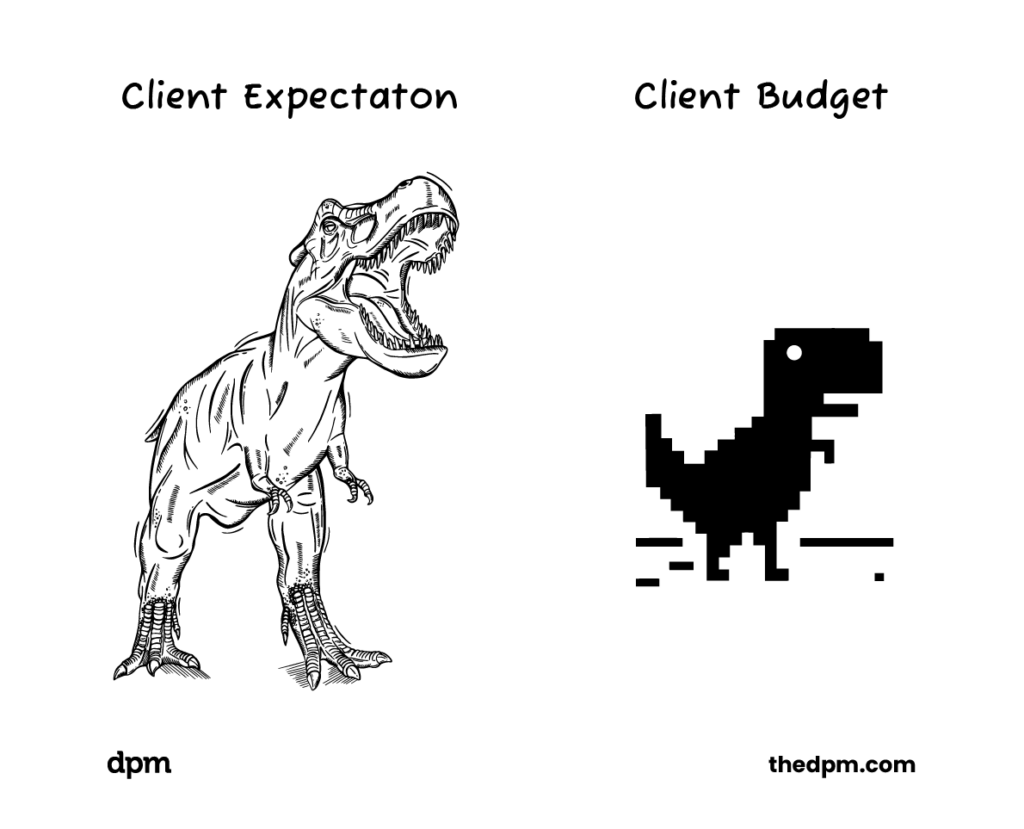
It’s good to have some sense of a client’s budget before you start doing anything. Often a client will claim they don’t know their project budget, which means you’ll need to discuss a few options. You could try throwing out a few numbers and gauge the client’s reaction.
Say something like, “How would you feel about spending $75,000 for this work?” If the client says that sounds really high, you’ll know that you need to aim lower, or if you know based on your understanding of the project that you cannot complete a successful project based on that number, you can shut it down here and now.
Even if this is new territory for you and your potential client, the person signing the checks should have some idea of what they anticipate spending or what they are allowed to spend.
Getting this information upfront will save you a lot of time and back and forth, or the disappointment of spending hours creating an estimate/proposal that doesn’t fit your client’s needs.
3. Have A Plan For The Project
When you’re estimating a project, it’s much easier to do if you’ve got at least a simple project plan. The reality is that you’ll need to edit the project plan (and project schedule) to align with the estimate, and you’ll need to refine the estimate to align with the project plan.
The relationship between cost estimation and project plan is symbiotic; they feed from one another. If you dive straight into an estimate with no plan, you’ll quickly discover that you’ll need an accompanying project plan for it to have any meaning.
That said, it can also be helpful for project planning if you do a quick top-down estimate. Think of it as similar to a project plan sketch. Its purpose is to put a stake in the ground and work out how much effort you could afford to apply to different phases of a project to see if it might be feasible.
One other key component of the plan that is especially important for estimates in an agency setting is considering who will work on the project and how much time they will spend.
For example, if you have three developers who do website work and they’re at different levels of seniority, they will bill at different hourly rates (assuming you’re estimating work at an hourly rate). Let’s say the most senior developer bills at $250/hour, the mid-senior developer bills at $175/hour, and the junior developer bills at $115/hour.
You will need to base your estimate on who is the most likely to work on this project and how much time you think they’ll need in each phase or to reach each milestone in the project.
Don’t forget to include some billable time in your estimate for senior leaders to consult on or review work. This could be your lead developer looking at some code or the creative director helping to ensure brand standards are being applied correctly.
4. Know Why You’re Estimating
Are you estimating to get an accurate project budget? Or are you estimating to hit a specific number? Are you trying to win new business or sell a project as a loss leader to get more work down the line? Do you want to invest heavily in the upfront discovery, which can be leveraged for a group of projects in the future, or is it a risky technical project where more effort should be allocated for development?
Cost estimation will always have a context. Knowing the full picture ensures that you don’t waste your time producing something that might be technically correct but totally inappropriate for the project.
5. Know What Kind Of Estimate You Need
In the run-up to a project budget being signed off by a client, there’s a process of defining the budget. So how do you make sure you’re not wasting time creating a detailed cost estimate that’s way outside of a client’s budget? At different phases of a project, we can use different types of estimates.
Project Estimate FAQs
When should project estimates be created?
Project estimates should be created to help make decisions about projects. This could be to help the team or client decide if they are going to move forward with a project or to determine the final budget for a project before it kicks off.
It’s possible you will need to do a more general rough estimate in the early stages of planning for a project and a more detailed accurate project estimation in order to get a signed and executed statement or work or contract.
Does estimating matter in agile projects?
It does, but it’s not done the same way as in a traditional waterfall project. In agile, work is categorized into a product backlog and delivered in sprints. During the sprint planning meeting, features are estimated to be completed within the sprint. Throughout the course of the work, new items are added to the backlog, and items may be removed if they become obsolete.
So, how can this work in an agency or contract project where you need to give a client an overall price for the work and set a timeline for completion? It can be a challenge!
Is it better to over or under-estimate projects?
One of your project manager responsibilities is to deliver projects profitably and on budget. So the easy and safe option can be to over-estimate and add lots of padding to your estimate to make yourself and your team look like superstars when you come in at or under your budget.
But, one project risk associated with inflating your budget is that it could cost your agency the entire project. If you estimate too high, the project could get written off as too expensive and never get started.
If you end up going to the other extreme and underestimating the budget for a potential project in order to accommodate a client, you risk putting your agency or team in a position to potentially have to run the project at a loss or cut corners and sacrifice quality in order to deliver.
The real answer: walk the estimate tightrope. Getting the balance right between estimating too high or low enables you to manage the tension between these two elements, safety and risk— creating a cost estimation that the client can buy but that’s high enough to enable you to deliver on budget.
Managing the Final Project Budget
Once you’ve established a budget (and it’s approved by the client), you’ll need to manage and track budget usage throughout the project. You can use your project management software to allocate and manage your budget (as well as track everyone’s to-dos).
There are several ways to do this, which we don’t have time to cover in this article fully. But we’d never let you go without resources for managing your budget, so make sure to check out our articles on the project management life cycle and scope creep for some expert tips.
Check out this real life example of budget management, where the project manager had almost zero funds.
What’s Next?
Need more project budgeting help or some project budget management advice? Check out Galen’s article on ways to improve your project estimation process, and find out more about how accurate time tracking can help improve your project budgets.

